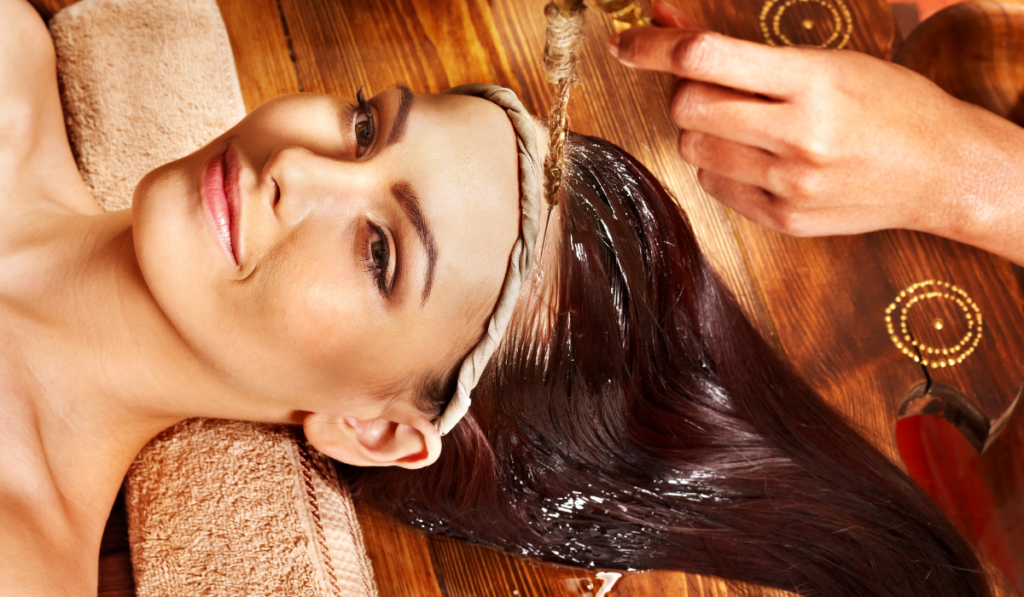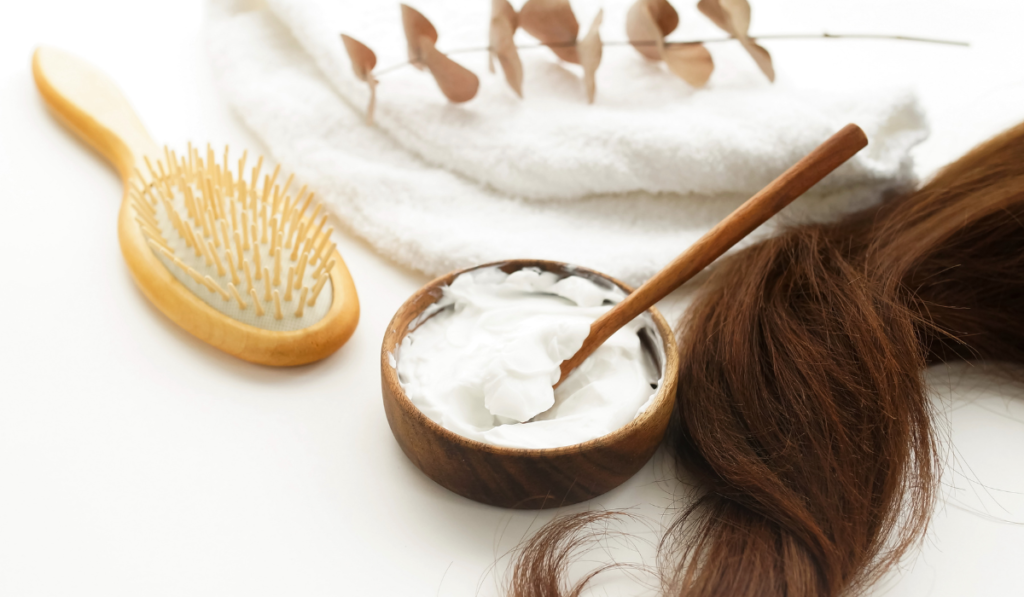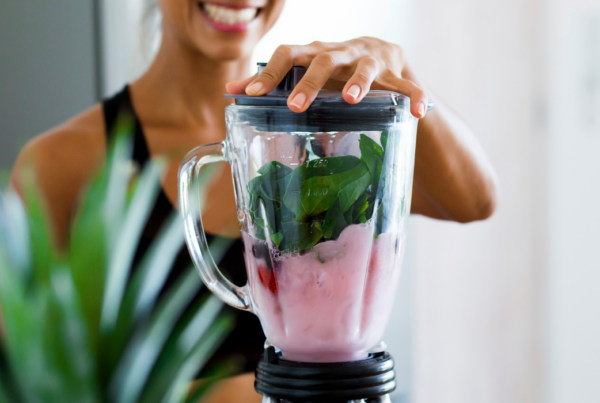Ayurvedic hair treatment involves the use of natural ingredients to nourish and care for the hair and scalp. One popular Ayurvedic practice is Shiro Abhyanga, which is a form of oil massage. In this treatment, warm oils such as coconut, almond, or amla are applied to the scalp and hair, massaged gently, and left on for at least 30 minutes before washing the hair. This helps in promoting hair health, improving blood circulation, and providing essential nutrients to the hair and scalp. Ayurvedic hair treatments often focus on harnessing the benefits of botanical extracts, oils, and herbs to enhance the overall well-being of the hair.
Creating a natural hair treatment involves combining diluted apple cider vinegar, lemon juice, and honey. This mixture is known to effectively reduce excess oil on the scalp. Another beneficial treatment option is a blend of egg whites, almond milk, and coconut oil. Simply apply this mixture to dry hair and rinse it off after 15 to 30 minutes for healthier-looking hair.
Straight hair is a prevalent hair type worldwide, with each individual possessing a distinct texture.
Different Types of Hair:
- Type 1 – Strt: – 1A – Fine and thin. – 1B – Medium and textured. – 1C – Coarse and thick.
- Type 2 – Wavy: – 2A – Loose waves. – 2B – Slight waves with more texture. …
- Type 3 – Curly: – 3A – Loose curls with a well-defined S shape. – 3B – Medium curls with more volume.
Basic Home remedies treatment of hair loss?

In Ayurveda, hair texture is linked to imbalances in one’s constitution. Understanding your prakriti (constitution) helps determine remedies. Moreover imbalances in Vata result in dry, frizzy hair; Pitta leads to thinning, receding hair with color changes; and Kapha causes oily, sticky hair, contributing to hair fall. Normal Vata hair is dry, Pitta is thin and may turn brown, while Kapha hair is naturally thick. Addressing these imbalances guides personalized hair care.
What is Dosha ?
Ayurveda, the traditional medical system of India, has delineated three categories of fundamental regulatory principles of the body, mind, and behavior. Moreover these three categories, called doshas, are named Vata, Pitta, and Kapha.
Whether you are aware of the cause of a condition or not, you must eliminate toxins from your body. Therefore, detoxification is crucial.
| Type of Dosha | Hair qualities | Dosha imbalance can lead to various hair issues, including dryness, oiliness, thinning, or loss of shine. |
| Vata (air and space elements dominate) | Likely to become dry and easily break apart. | Dry, frizzy hair with dandruff and split ends |
| Pitta (fire element dominates) | Tendency to be slim, greasy, and smooth. | Hair turning gray and falling out early. |
| Kapha (earth and water elements dominate) | Tendency to become both oily and thick. | Hair roots are stuck and your scalp is really, really oily. |
Hair loss treatments with Ayurveda
Ayurvedic hospitals offer different treatments for a healthier you. Moreover using various oils, they clean and nourish your head. Here are some simple procedures to keep your head and hair in good shape!
Shirodhara and Shiro Abhyanga
- Warm oils are poured on your head and massaged for better hair growth.
- Oils like Bringamalakadi Taila are used to nourish the roots and scalp, preventing hair loss and graying.
Ayurvedic Oils
- Brahmi Bringaraj Taila reduces hair fall, prevents dry scalp, and destresses.
- Bringamalakadi Taila promotes hair growth and treats issues like arthritis and back pain.
Shirolepa Hair Pack
- A paste is applied to cool the head, eliminate dandruff, control frizz, and reduce hair fall.
- Various effective pastes include fenugreek seeds with rice water, besan with lemon and coconut water, and walnut with amla.
Nasya
- Instilling oil through the nose, like Desi ghee and Anu Tailam, provides relief from ailments.
Quick Tips
- Avoid brushing wet hair, stay hydrated, and avoid smoking and alcohol.
- Consume raw vegetables, sleep adequately, and follow healthy practices.
Ayur Soundarya Program
- A workshop for women promoting beauty and health through healthy practices.
Herbs and Hair Cleansers
- Use herbs like Aloe Vera, curry leaves, hibiscus, amla, methi, coconut oil, and sesame oil.
- Natural cleansers like Shikakai, Aloe Vera, Hibiscus, Amla, and Besan promote healthy hair.
Aloe Vera, Curry Leaves, Hibiscus
- These herbs can be consumed or applied for nourishing the head and promoting hair health.
- A versatile gem for skin and hair. Clears blocked pores, refreshes the scalp, and fights dandruff. Moreover apply pure gel a few times a week.
- Rich in Vitamin C, it boosts hair growth and maintains a healthy scalp. Apply lemon juice before washing or use lemon oil for scalp health.
- Packed with protein, these leaves promote hair growth, strengthen follicles, and moisturize the scalp. A simple addition for improved hair quality.
Hair Cleansers
- Shikakai is a natural cleanser that removes excess oil. Combine with reetha, amla, and hibiscus for frizzy and dry hair.
- Aloe vera gel is a cooling and soothing scalp cleanser, ideal for a heated scalp with redness or itching.
- Hibiscus leaves and flowers, when ground into a paste, provide nourished, strong, and black hair.
- Amla or Indian gooseberry, mixed with tea, reetha, or shikakai, helps maintain hair health.
- Besan or gram flour mixed with water can be used to wash hair after an oil massage.
Dietary Considerations
- Your diet plays a crucial role in the quality and quantity of your hair.
- Take care of your agni or metabolic fire for healthy hair growth.
Hair Growth Cycle

The Four Phases of the Hair Growth Cycle:
- Anagen
- Exogen
- Telogen
- Catagen
Anagen Phase
The Anagen Phase, sometimes referred to as the “Growth Phase” or the “Active Phase,” is the time when your hair’s root cells divide at their fastest rate, producing more new hair. In the Anagen Phase, hair grows approximately 6 inches a year, or half an inch per month, with summertime growth being faster than wintertime.
How much time is there in the Agagen Stage?
An average full-length hair growth, measuring between 18 to 30 inches, occurs during this phase of the hair growth cycle, which lasts three to five years on average. People of Asian origin typically have longer anagen phases, which can extend up to seven years, allowing hair to reach up to three feet in length!
Catagen Phase
As the Anagen Phase in your hair cycle concludes, individual hairs undergo the cessation of blood supply, and the cells forming new hair signify the end of active growth, marking the brief transitional phase called the Catagen Phase. Moreover in this stage at any given time, about 3% of all hairs are.
What is the duration of the Catagen Stage?
About a period of 10 days.
Telogen Phase
The Telogen Phase, a resting phase during which hair strands stay in their follicles but are not actively developing, is the third stage of your natural hair development cycle. Moreover at any given time, 10–15% of your hair is thought to be in the Telogen Phase.
What is the duration of the Telogen Stage?
Roughly 100 days or three months.
Exogen Phase
The last phase of the hair growth cycle, at which time individual hair strands fall out of their follicles. The entire process can now start over!
When the Hair Growth Cycle Is Interrupted, What Takes Place?
Individual Hair Growth Cycles
Each hair on your head follows its own growth cycle.
This individual cycle helps prevent simultaneous shedding of all hair.
Normal Hair Loss
A healthy scalp typically loses 80 to 100 hairs daily.
Disruptions in Growth Cycle
Hair problems, such as thinning or loss, can result from disruptions in the natural growth cycle.
Causes of Disruptions
Factors like illness or poor nutrition can disrupt the hair growth cycle.
Telogen Effluvium
After a restrictive diet or high fever, sudden hair fall may occur about 12 weeks later.
This condition is known as telogen effluvium.
Consistent Disruptions
Inadequate nutrition or consistent disruptions can prevent hair from growing as long as before.
Importance of Nutrition
Good nutrition is essential for maintaining a healthy hair growth cycle.
Shedding Phase (Exogen)
During the shedding phase, which lasts 2 to 5 months (exogen), old hairs fall away.
Simultaneously, new hairs grow to replace the ones shed.
Maintaining a Healthy Hair Growth Cycle
Ensuring proper nutrition and addressing underlying health issues are key to maintaining a healthy hair growth cycle.
Long-Term Impact
Persistent disruptions, such as ongoing inadequate nutrition, can lead to a reduced ability for hair to grow as long as it did before.
Factors That May Cause Hair Loss
Genes
One major contributing reason to baldness could be genetics. Moreover take a look around. Moreover there’s a good risk you could encounter the same problem if members of your immediate family seem to be experiencing thin hair or hair loss.
UV rays
UV radiation from the sun is just as bad for hair as it is for skin. Moreover UV rays damage hair and dry it out, which leads to hair breakage and damage.
Hormonal changes or medical conditions
Your hair development may be impacted by or slowed down by pregnancy, menopause, and other hormone-related diseases. Moreover this could be long-term or just brief. Alopecia and other diseases also have a role in balding.
Styles & treatments for hair
Regularly utilizing heat styling products or tying your hair up too frequently might lead to damage. Inflammation of the hair follicles could also result in hair loss during hot oil hair treatments.
medication reason
Several medications used to treat specific conditions like depression, high blood pressure, and arthritis can cause hair loss.
A Diet To Promote Hair Growth
Reviving your current damaged hair follicles is vital for improving hair growth. Moreover to energize hair growth, your body needs a significant amount of energy. Moreover enhance this process by incorporating specific nutrients in your diet. Moreover include these vitamins and minerals for better hair development, and explore Ayurvedic hair treatment methods to complement your efforts in nourishing and rejuvenating your hair.
Omega-3 Fatty Acids
Omega-3 and omega-6 fatty acid consumers showed less hair loss in studies including women.
Zinc
According to research, hair loss may be exacerbated by a zinc shortage. moreover you can promote hair growth by including it in your diet or taking supplements.
Vitamin C
Vitamin C, predominantly found in citrus fruits, may play a role in preventing hair thinning. Moreover its antioxidant qualities assist the body in combating free radicals, which can contribute to firmer-looking hair. Moreover free radicals are known to have the potential to damage DNA, leading to hair loss. Incorporating Ayurvedic hair treatment practices alongside a vitamin C-rich diet could further enhance the overall health and resilience of your hair.
Iron
According to doctors, the normal ferritin levels for women range between 20 and 200 nanograms per milliliter, while for men, it’s between 20 and 500 nanograms per milliliter. Therefore interestingly, most researchers suggest that for effective hair renewal, individuals should maintain ferritin levels between 50 and 70 nanograms per milliliter. Moreover elevate your hair care with Ayurvedic hair treatment for optimal results in promoting healthy locks.
Vitamin D
According to studies, vitamin D deficiency was seen in alopecia sufferers. Moreover balding is brought on by alopecia. Furthermore, research indicates that vitamin D helps your body produce microscopic hair follicles.
FAQ’s
What is the ideal type of hair?
Straight hair typically maintains a balanced sebum production, nourishing and preserving strand suppleness. Moreover categorize straight hair as follows: Type 1A showcases a remarkably smooth, glossy, and silky texture. This hair lacks volume, even though a lot of people might think it’s ideal.
How does Ayurveda advise taking care of hair?
Maintaining proper hair hygiene involves using gentle shampoos and avoiding excessively hot water during hair and scalp washing. Ayurveda recommends consuming cold or lukewarm water for overall well-being. Additionally, incorporate an Ayurvedic hair treatment routine by conditioning your hair weekly with a natural blend of triphala, hibiscus, curd, and methi. Therefore this holistic approach contributes to stronger and silkier hair.
How many times a week do you wash your hair?
To maintain the natural oils on your scalp, it’s advisable to wash dry or damaged hair every five to seven days. For fine or thin hair, incorporate moisture every other day, while curly or wavy hair benefits from washing every four to five days, adjusted to hair density. Moreover achieve optimal results by engaging in a weekly coiling ritual. Consider integrating Ayurvedic hair treatment into your routine to enhance the overall health and vitality of your hair.
Who is the Ayurvedic guru?
Charak and Sushrut are the two principal Ayurvedic reorganizers whose contributions are still in use today.
Which book on Ayurveda is the oldest?
The oldest and most reliable book on Ayurveda, the traditional Indian medical science, is the Charaka Samhita. It provides useful information on India’s geographic, social, and economic circumstances in addition to medical conditions and their treatments.








